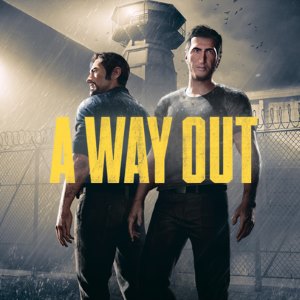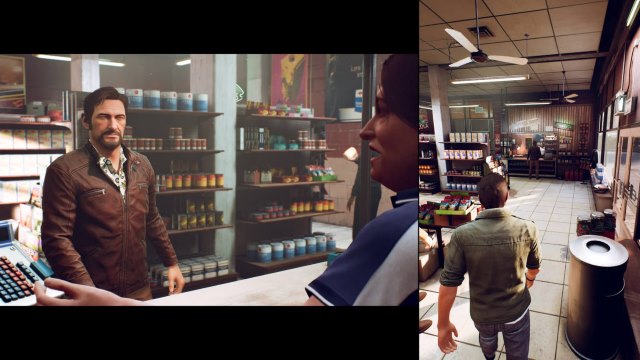
It’s very unusual for a game to be so reliant on co-op that there’s absolutely no way of playing it without another person coming along for the ride. While most co-op games let you trundle along with an AI, or have other areas of the game to do alone, A Way Out demands that you’re not alone in the journey. That’s a brave choice, so does the game match up to it?
On the whole, yes it does. Sure there are moments when one player is slightly redundant, but on the whole this story of a pair of blokes breaking out of jail and trying to make a decent escape once they’re out works nicely with the team-based gameplay it sets out to offer. The screen is generally split vertically down the middle, which makes sense with the widescreen nature of modern TVs, and gives both players a clear viewing area to make sure they can both see what’s going on. In big moments, cut scenes or moments when there’s no need for both players to have their own screen the split sweeps away, usually to offer a full screen view of the action but occasionally matching the game’s 1970s theme by cutting to multiple frames on screen at once, mimicking the cop shows and films from that time. It’s a neat feature, although there were a few cut scenes that seemed quite lengthy, while others felt like they didn’t really need to be cut scenes at all. Nothing too crucial, but enough to add an unnecessary amount of waiting into the game.
The co-op features work in several ways, through helping each other out during the escape, working together to take down multiple enemies at once without raising an alarm or giving each other a leg-up over a high wall. Quite often you can be going about your own tasks quite independently, wandering around while the other person digs a tunnel, or distracting guards so your buddy can do something equally against the idea of being imprisoned. It’s nice to drift apart for a while only to come back together for a big shoot-out, or accompanying each other on a car drive or whatever. It feels right to be working together in the way that you have to, and rarely feels like you’re doing stuff just because the developers thought there wasn’t enough co-op stuff to do.

While this works best with someone else sitting on the sofa next to you, you can also play it online thanks to the trial of the intriguing “friend pass”, allowing one of your PSN friends to join in and play with you even if they don’t own the game themselves. Very cool. Either way you’ll want to be able to speak to the other person. Trying to coordinate your efforts through in-game movements is impossible, and an excellent reason why the game doesn’t feature any matchmaking to team you up with random people. You need to share this with someone you know, so if you’ve got someone who can spare a few hours to come and sit with you and play it split-screen in the same room, that’s the way to go about it.
In terms of controls everything feels fine. Not spectacular, and it’s not going to make you think that Uncharted was a waste of time, but it does a reasonable job of keeping things together. Driving, moving, shooting, sneaking, it’s all handled well enough to not get in the way, but it never quite feels razor sharp in the way that you might hope. That said, it’s quite friendly for people who don’t play games all that much, so maybe that’s an intentional decision to attract more people to enjoy the cooperative gameplay together.
And so while A Way Out isn’t going to break any records or be seen as one of the great games of the year, it’s original and interesting enough to warrant taking a look at. The co-op only play was a risk, but one worth taking, and the storyline ticks along nicely and keeps things interesting enough to want to reach the end. If you’re looking for a game to play with a friend that isn’t too heavy going, doesn’t last overly long and won’t break your brain with complex controls or concepts then this could be right up your street.
Reviewed on PS4


Leave a Reply